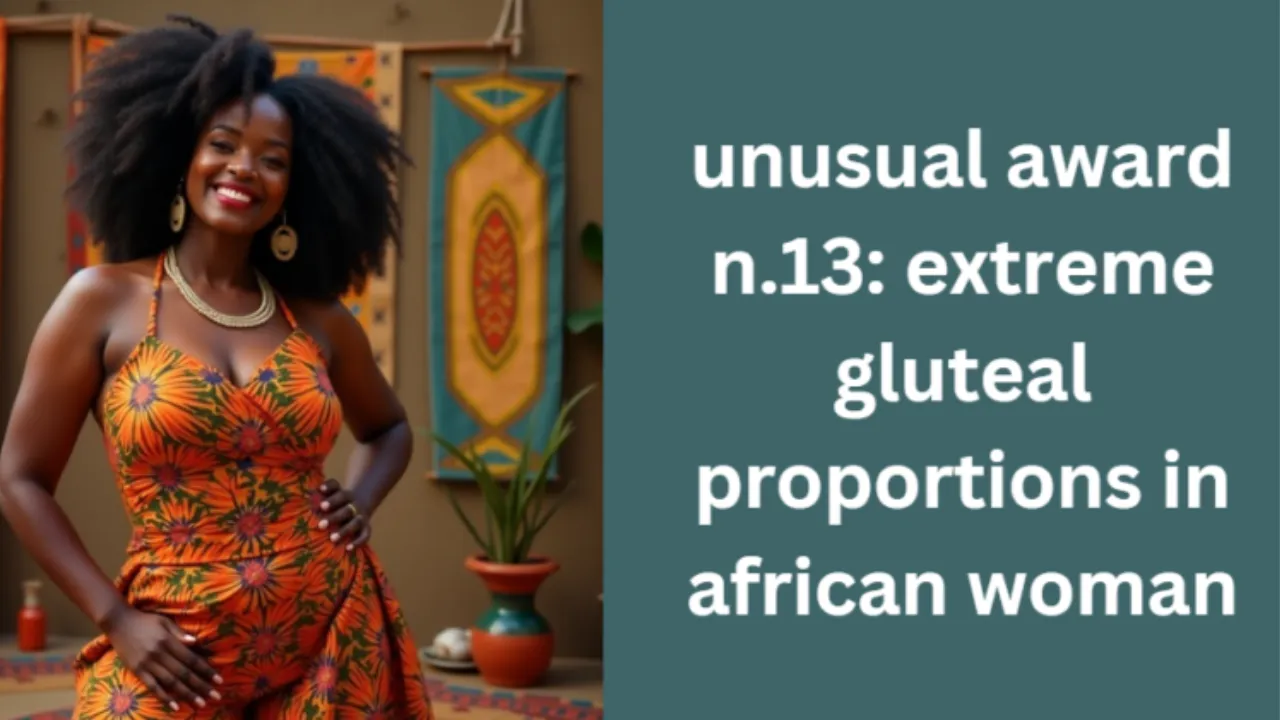Unusual Award N.13: Extreme Gluteal Proportions in African Woman

The term unusual award n.13: extreme gluteal proportions in African woman sounds sensational, but it leads us to a deeper understanding of human biology, history, and cultural standards of beauty. This phrase may seem humorous or odd at first, but it brings attention to a very real and historical fascination with body diversity—especially in African women. Let’s explore what it really means, where it originates, and why it’s important to understand this context respectfully.
What is Unusual Award N.13: Extreme Gluteal Proportions in African Woman?
The phrase unusual award n.13: extreme gluteal proportions in African woman might sound like satire or internet humor, but it actually points to a real biological and cultural phenomenon. This “award” isn’t literal. Instead, it draws attention to a unique body trait—steatopygia—that is naturally found in some African women. This trait refers to the prominent fat distribution around the buttocks and thighs, creating what many see as extreme gluteal proportions. While rare in global populations, this trait is relatively more common in specific African ethnic groups such as the Khoisan.
What Does It Mean?
The phrase extreme gluteal proportions in African woman might not be from any official source. It’s most likely taken from internet memes or pop culture content that tries to showcase unique or exaggerated human features. However, behind this seemingly bizarre “award” is a topic with significant anthropological, biological, and cultural depth.
In African populations, particularly among the Khoisan people, women are known to have steatopygia, a condition involving the accumulation of fat on the buttocks and upper thighs. This feature is not a disorder, but a naturally occurring trait that has attracted both scientific and social attention over the years.
Steatopygia: The Science Behind the Shape
Steatopygia is a genetic condition seen in certain African ethnic groups. It is especially common in women and presents as a high concentration of fat in the gluteal area. This physical feature is not a result of diet or lifestyle—it is inherited and perfectly healthy.
Here is a simple breakdown of steatopygia:
| Feature | Description |
|---|---|
| Affected Region | Buttocks and thighs |
| Most Common In | Khoisan people of Southern Africa |
| Cause | Genetic adaptation, likely for fat storage in dry climates |
| Health Impact | No negative health impact; often associated with fertility and strength |
The extreme gluteal proportions in African woman draws attention to this body type, though sometimes in insensitive ways. However, understanding its biological basis helps us respect body diversity better.
Sarah Baartman: The Tragic Story Behind the Fascination
When talking about this topic, it’s impossible to ignore the historical example of Sarah Baartman, a Khoikhoi woman from South Africa. She became famous—or rather, infamous—in the 19th century when she was taken to Europe and displayed in freak shows because of her steatopygia.
Sarah Baartman’s story reveals the painful truth about how African women have been objectified and dehumanized. Audiences in Europe paid to see her body, and she was referred to as the “Hottentot Venus,” a term that stripped her of her dignity and humanity.
Long after her death, her remains were displayed in museums until campaigns by South African leaders demanded her return. In 2002, she was finally buried in her homeland with respect.
This example connects directly to the phrase unusual award n.13: extreme gluteal proportions in African woman, which may seem amusing but actually echoes a long history of fascination with African women’s bodies.
Cultural Perceptions of Beauty
Across African cultures, fuller bodies are often seen as symbols of health, fertility, and beauty. In many African communities, large hips and buttocks are celebrated, not criticized. Women with these features are considered attractive and desirable.
In contrast, Western beauty standards—especially in past decades—often idealized thinness. However, over the past two decades, there has been a shift. With the rise of social media and global influence, curvier figures have gained popularity even in Western culture.
Ironically, what was once seen as “unusual” or “exotic” is now widely copied and celebrated through fashion, fitness trends, and even cosmetic surgery. This brings us to a deeper discussion about cultural appropriation, where traits of one culture are embraced by another without understanding their origins.
Also Read: IodaRacingd.com: Where Motorsport Fans Stay Updated
Modern Media and Body Trends
With the influence of celebrities like Beyoncé, Nicki Minaj, and others, the curvy body ideal has gone mainstream. Fitness influencers promote “glute workouts,” and cosmetic surgeries like the Brazilian Butt Lift (BBL) are more popular than ever.
Yet, many of these trends mimic features that African women have had naturally for generations. This global trend again links back to the phrase unusual award n.13: extreme gluteal proportions in African woman, reminding us that what was once mocked is now admired—though often without giving credit to the origin.
Here’s a comparison of cultural views:
| Culture | View on Gluteal Proportions |
|---|---|
| African Cultures | Symbol of beauty, strength, and fertility |
| Historical West | Objectified or misunderstood |
| Modern Media | Celebrated, often replicated artificially |
Also Read: Make1m.com: Turn Your Million-Dollar Dreams into Reality
Respecting Body Diversity
Instead of treating these traits as “awards” or unusual oddities, we should aim to respect all body types. Women, regardless of their size or shape, deserve to be appreciated without judgment or exoticism. The phrase unusual award n.13: extreme gluteal proportions in African woman might get laughs online, but it should spark a conversation about inclusiveness and respect.
Young girls growing up with naturally fuller figures should feel confident, not ashamed. Representation matters, and it begins by shifting how we talk about bodies—especially those that have been historically ridiculed or misunderstood.
Moving from Objectification to Empowerment
Women today are pushing back against labels and stereotypes. They are using their voices to reclaim their bodies and celebrate their natural features. Movements promoting body positivity have allowed African women to embrace their shapes without feeling pressure to conform to Western ideals.
Unusual award n.13: extreme gluteal proportions in African woman should not be viewed as a joke or mockery. Instead, it can be redefined as a celebration of natural diversity and an opportunity to educate others about history, genetics, and culture.
Also Read: TravellingaApples.com: Your Ultimate Travel Resource

Representation in Media and Pop Culture
In the 21st century, many celebrities and influencers have popularized fuller body shapes. This includes not just African women but women of African descent around the globe. In music, fashion, and film, curvy figures are now celebrated, and the media has played a significant role in shifting public opinion.
However, there is a fine line between celebration and objectification. When society highlights features like extreme gluteal proportions only for entertainment or shock value, it can devalue the person behind the body. This is why it’s important that terms like unusual award n.13 extreme gluteal proportions in African woman be used thoughtfully.
Also Read: MyGreenBux.net: Earn Money, Payment Methods & Security
Conclusion
The phrase unusual award n.13: extreme gluteal proportions in African woman may originate from humorous or exaggerated online lists, but it reflects something much more important. Behind the curiosity lies a history of both exploitation and celebration. From the biology of steatopygia to the cultural symbolism in African societies, these features are not “unusual”—they are beautiful and significant.
By understanding the science, culture, and history, we move toward a world that honors body diversity and avoids stereotypes. Whether used in jest or fascination, we must be careful about how we label human features. In the end, every body is worthy of respect, understanding, and appreciation.
Also Read: Falmyhit.com: A Complete Informational Guide






